Topics:
Never Miss a Beat - Get Updates Direct to Your Inbox
FILTER:
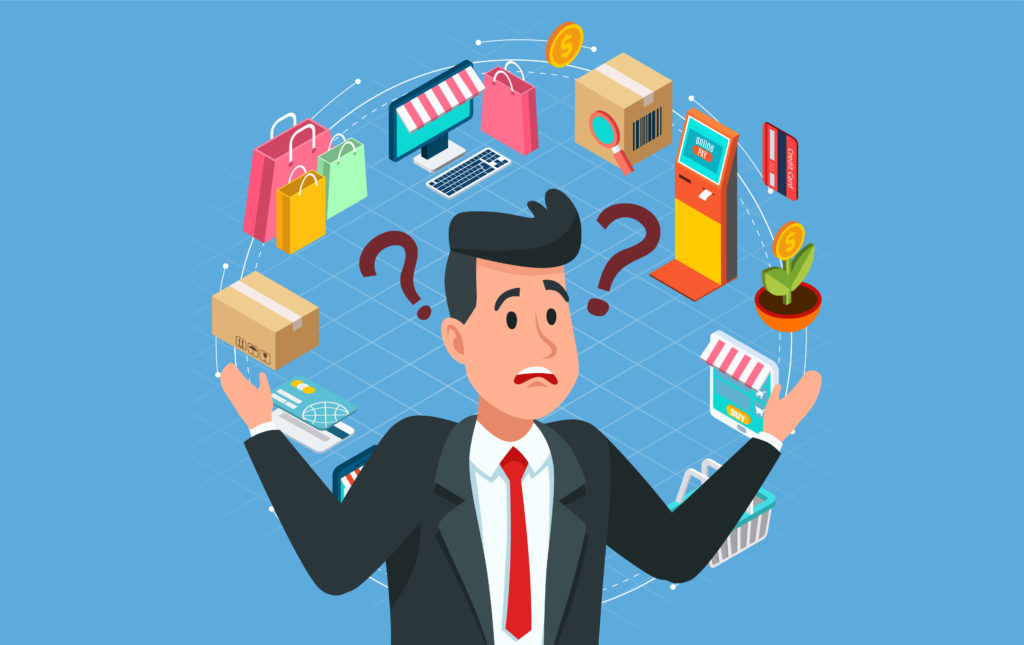

The Complete Guide for Choosing Profitable Amazon FBA Products to Sell
By Ian Drogin
You’re convinced that Amazon is the right platform to help scale your business and now it’s time to decide what new products you should launch. Indeed, making smart product launch decisions is an important element to Amazon seller success!
This article will discuss various product selection strategies, as well as how you can build a reliable supply chain to fuel the growth of your Amazon FBA business.
Sourcing and Selling Popular Products
Of course, every entrepreneur wants to sell products that have a strong demand. Ensuring that there’s a healthy market for your offer is foundational to success.
When trying to decide what to sell on Amazon FBA, most sellers start with a basic question: “What products are popular on Amazon?”
There are two primary ways to define what is popular, and each implies a different strategy in the creation process. These include:
- Products with a steep growth trend (emerging market)
- Products that have a long, proven history of consistent demand
The Benefits of Entering an Emerging Market
One strategy is to enter an emerging market that has a strong positive growth trend. Because such markets are relatively new, there is typically lower competition for a new Amazon FBA seller to deal with.
Lower competition means that it’s usually easier to gain traction when launching new products. If the products on page one for a particular search term only have 40 reviews on average, it’s going to be a lot easier to enter the market than if you’re going up against competitors that each has 10,000 reviews.
Sometimes, entering an emerging market can end up being a very smart long-term strategy. For example, sellers who entered the pickleball market back in 2012 have now enjoyed almost nine years of consistent, positive market growth.
The yoga mat is another product that has experienced consistent growth, although the curve hasn’t been nearly as steep in recent years.
While there are numerous benefits to getting in early, there are also some risks.
Buy a Profitable Online Business
Outsmart the startup game and check out our listings. You can request a summary on any business without any further obligation.
The Risks of Entering an Emerging Market
Emerging markets offer ample opportunity and lower competition. However, there are also some serious risks associated with entering uncharted product territories.
On the flip side of launching a product that’s trending is a tough reality. A lot of products with steep growth curves disappear almost as quickly as they blew up. One year, you might sell 2000 units on Cyber Monday. The next your, your Cyber Monday sales might drop to just 100 (in an extreme case).
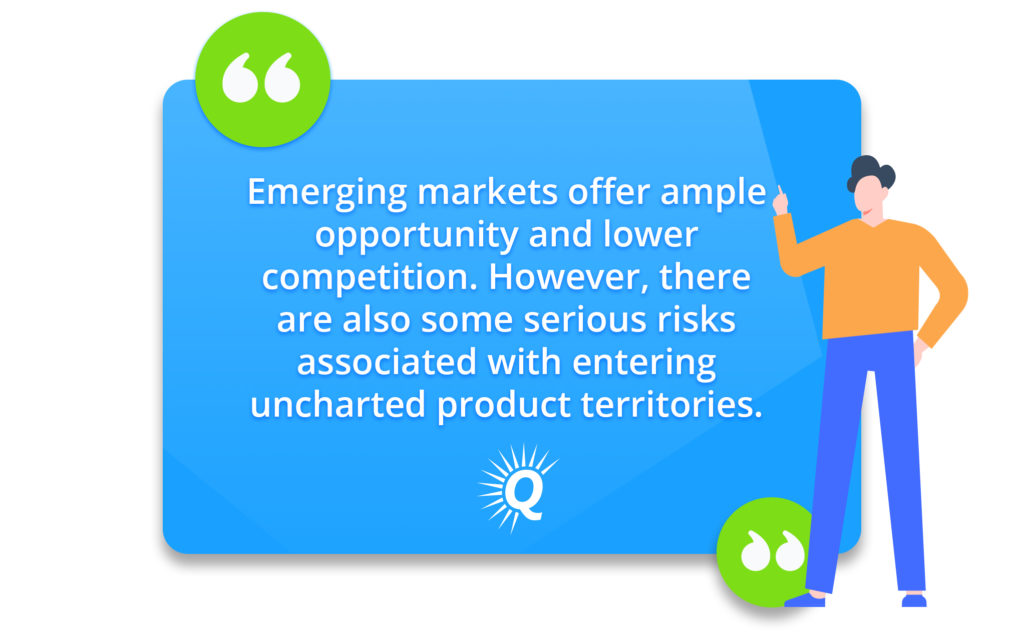

For example, the search volume for selfie sticks increased nearly 10X between mid-2014 and 2015. However, by the end of 2016, their popularity sank and the search volume nearly returned to what it was in 2014. Sellers who originally thought they got in early on a long-term trend needed to rethink their selling plan.
The Benefits of Selling Popular Staple Products
Some sellers have a completely opposite approach when defining what products are “popular.” Instead of looking for emerging trends, they seek products that have a long history of consistent, stable demand.
Selling home goods such as towels and toothbrushes may not be flashy, but those markets probably aren’t going anywhere; it’s pretty unlikely that people are going to stop bathing or brushing their teeth anytime soon.
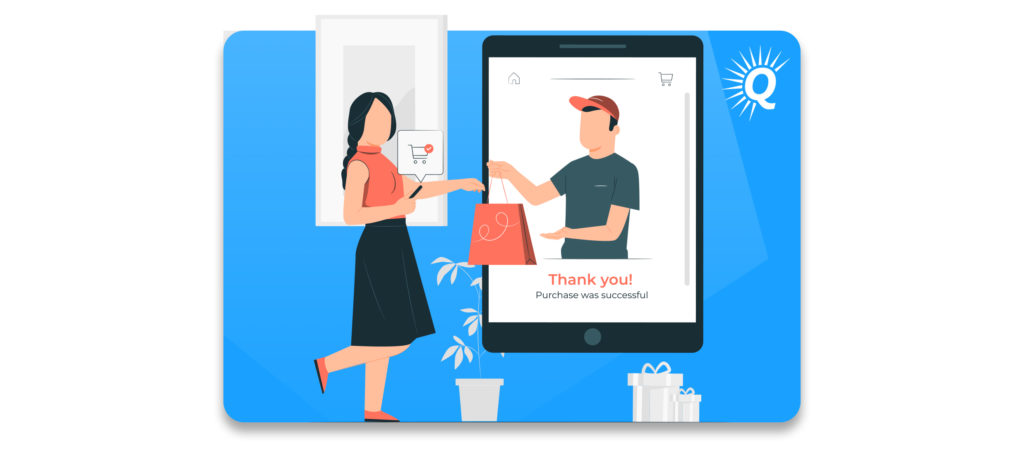

Everyday products such as these can be considered popular because there’s a high demand, even though there’s nothing new or exciting about them.
It’s important to note that although popular staple products generally don’t experience rapid changes in demand, demand can and usually does change slowly over time. For example, pet owners have been consistently spending more on pet products over the years.
The Downsides of Selling Popular Staple Products
There’s only one real downside to selling products with consistent, high demand: everyone else is already selling them…
If you can successfully gain momentum with a popular staple product, the chances are pretty good that you’ll experience a consistent and steady sales volume. However, entering such a market can be an arduous challenge that can require both time and money.
Because there are so many other FBA businesses selling high-volume essential products, successfully launching a new product listing could necessitate an enormous budget for advertising and growth strategies.
A considerable amount of time may be needed for your product listing to generate enough reviews to stand a chance against the long-established sellers in the space, as well as to ensure that you win the buy box for the product listing.
Regardless of which route you choose to go, there can be significant benefits to bundling your products to increase profitability. This video goes into detail about how to implement an effective bundling strategy.
Selling Products With High Margins
Ensuring that there’s demand for new product ideas is essential, but even a popular product is a bad idea if the numbers don’t add up. Therefore, it’s important to do your research to understand what your profit margins will look like once you’ve launched.
There are several key factors to consider when trying to find a profitable product:
- Production cost
- Transportation cost
- FBA fulfillment and storage fees
- Advertising
Estimate Your Production Cost
The most common way for Amazon sellers to source products is through Alibaba. In short, it’s a platform that allows you to engage in retail arbitrage by quickly finding suppliers for almost any product you want to sell. Many refer to it as “the Amazon for Amazon sellers.”
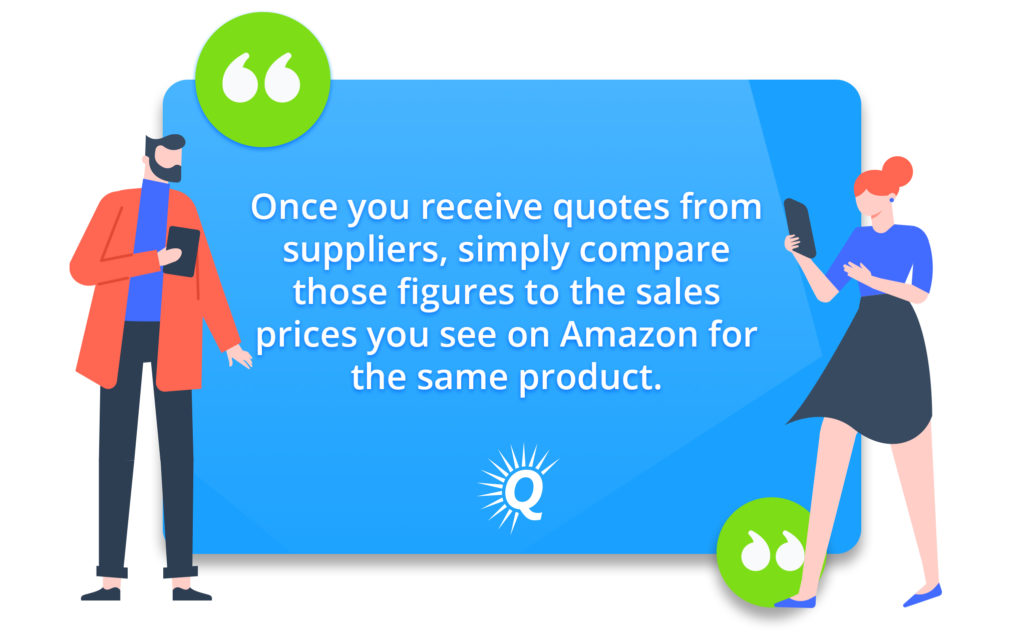

If you search for a product on Alibaba that you want to sell on Amazon, you’ll encounter a list of products with product cost information. The listed cost estimates in the search results can help you get a very rough idea of how much a product will cost to produce, but it’s important to directly communicate with suppliers to understand what your production costs will actually be.
Once you receive quotes from suppliers, simply compare those figures to the sales prices you see on Amazon for the same product. For example, if you see that a water bottle costs between $.79 to $3.50 on Alibaba and sells on Amazon for $14 to $36, that’s a very good sign.
Calculate Your Transportation Cost
Finding the right product with inexpensive production is one thing, but ensuring it doesn’t have a prohibitively high transportation cost is another.
Some products may appear to be promising on the surface but have extremely high transportation costs (this is especially true for large products).
When doing retail arbitrage, there are a few different ways to determine the transportation costs for various products. One method is to get quotes directly from shipping carriers. Although this might make sense in the long term, the easiest way is to request shipping quotes directly from your suppliers.
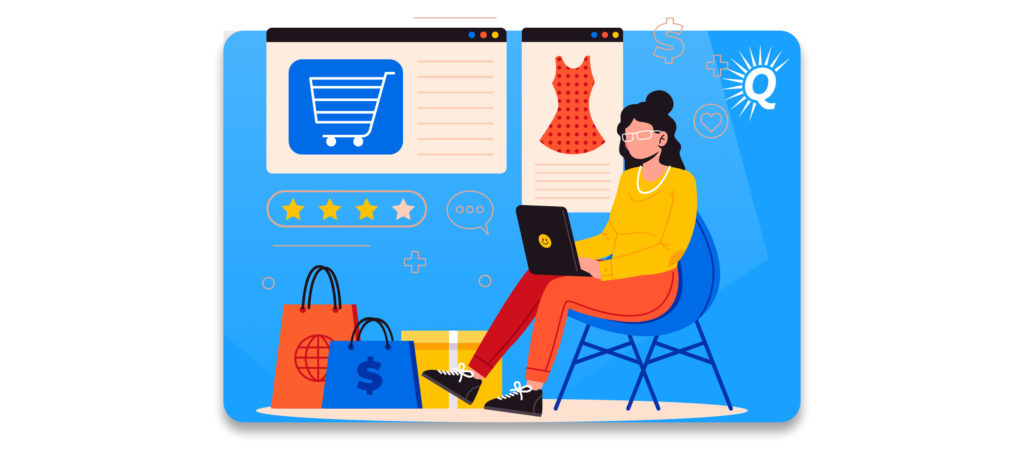

Many suppliers will provide quotes with FOB terms, which stands for “Free on Board.” Basically, this is the cost of the product without accounting for shipping, tariffs, or duty fees.
To get an idea of the shipping cost, you should ask for a quote with DDP terms, which means “Delivered Duty Paid.” This is the cost of the product including shipping and any duty that must be paid upon entry to your country. Be sure to have the DDP itemized in the quote so you can discern between the product cost and the DDP.
You’ll need to provide a shipping address for your supplier to provide quotes with DDP.
How to Figure Out Your FBA and Storage Fees
If you’re selling through FBA, Amazon will handle many of the core logistic activities required to deliver your products to customers. These include receiving inventory from suppliers, storing inventory, shipping orders, and processing returns. Needless to say, this removes a lot of headaches for you as a seller.
Amazon charges several different Amazon FBA fees for these services, each of which is based on various factors. The size of your products and storage time at Amazon’s warehouse are two critical variables.
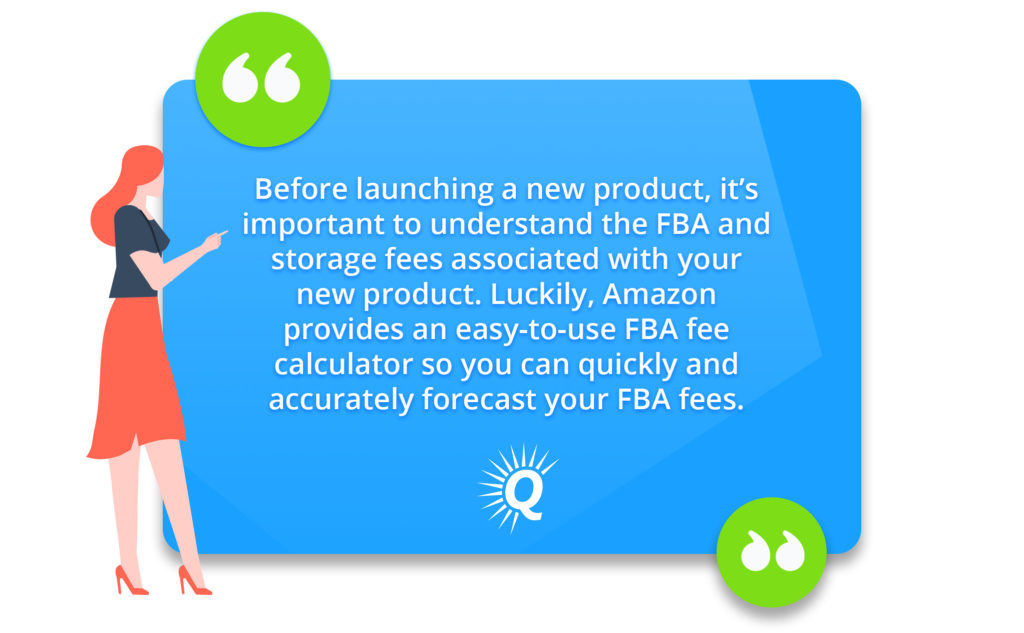

Before launching a new product, it’s important to understand the associated FBA and storage fees. Luckily, Amazon provides an easy-to-use FBA fee calculator to quickly and accurately forecast FBA fees.
The FBA calculator breaks down the fulfillment fee, storage fee, referral fees, and any other fees necessary to get your products from an Amazon fulfillment center into the customers’ hands.
At this point, you’ll have a pretty good idea if you’re considering a low or high-margin product. If it seems like there’s a good chance it will have a high margin using Amazon’s FBA program, it’s time to factor in your expected advertising cost.
Once you actually start selling the product, all FBA fees will be displayed within your Seller Central account.
Estimating Your Advertising Expenses
As an Amazon seller, advertising is a critical element of success. Therefore, it’s important to calculate your expected advertising expense into your estimation of profitability.
Within advertising, two key metrics are ACoS (Advertising Cost of Sale) and your Return On AdSpend (ROAS). Both of these can be ascertained using the Seller Central account.
ACoS is the rate at which an advertising dollar earns you a dollar in revenue. For example, if you spend $10 on advertising and earn $20 in revenue as a result, your ACoS is 50%.
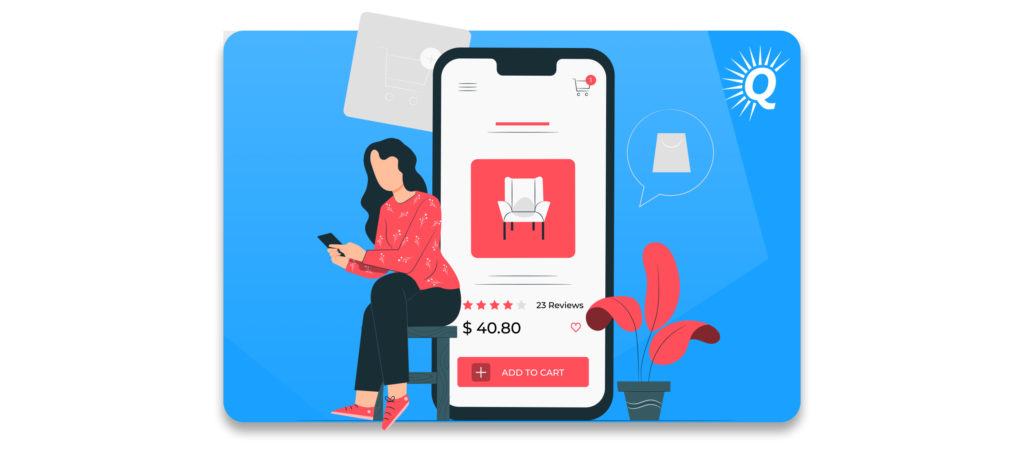

ROAS is a measurement of total revenue relative to total ad expense. In other words, it doesn’t just account for revenue that was earned as a direct result of your advertising expense. For example, if you spend $10 on advertising and your total sales are $50, then your ROAS would be 5X.
In general, many sellers expect their ACoS to be between 25% and 40%. The ROAS varies dramatically between products on Amazon, but a rough average is about 3X. Based on this, new sellers should expect to spend about $1 in advertising for every $3 earned in revenue.
If you account for all of these variables and things still look good, there’s a good chance that your product idea falls in the category of products with high margins.
Selling Products With Cheap Inventory
For a new FBA seller, it’s often important to minimize start-up expenses when first launching an Amazon FBA business. Sourcing inexpensive products is an essential step to keeping costs low.
There are both benefits and drawbacks to launching inexpensive products.
Pros and Cons of Launching Inexpensive products
The pros of developing inexpensive products are obvious: You don’t need to invest as much capital to get up and running. This allows you to have a lower budget, and dedicate more funding to other important business elements – such as marketing. What’s more, there’s less risk of losing large amounts of money if things don’t pan out.
Another benefit is that cheap products are often small and light. This means you have the option to choose air freight for shipping which is typically much faster than sea freight, allowing a shorter lead time and more flexibility when managing your stock level.
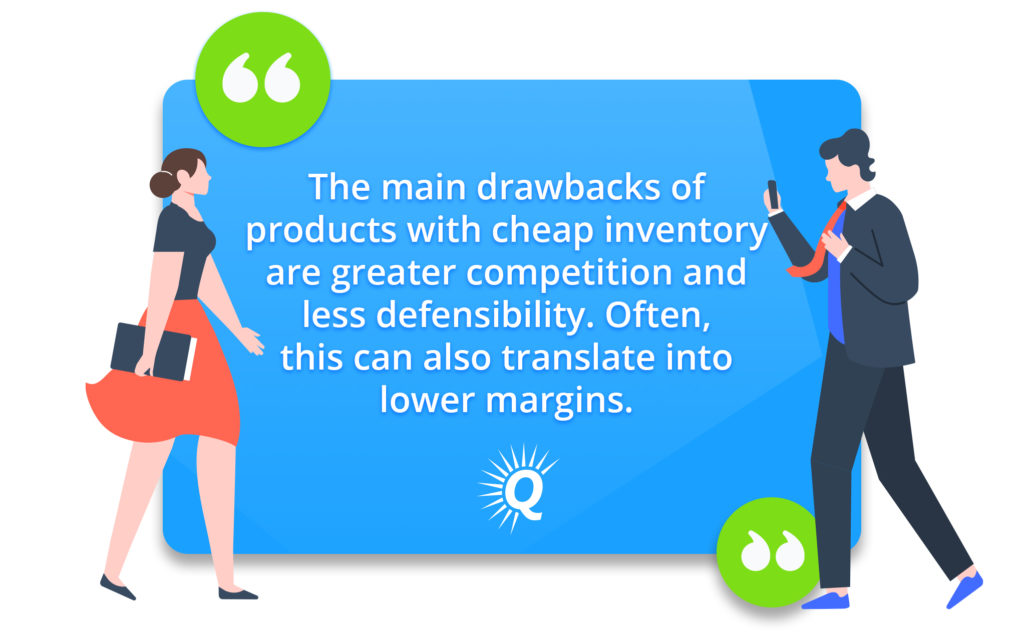

A shorter lead time makes inventory control an easier process. By reducing the need to carry several months of inventory at once, sellers can avoid many of the issues associated with excess inventory.
Nonetheless, it’s still a smart idea to implement an effective inventory management system, and perhaps use an inventory management app to keep track of stock.
While the advantages of cheap inventory are significant, it’s important to also understand the pitfalls.
The main obstacles for selling products with cheap inventory are greater competition and less defensibility. Often, this can also translate into lower margins.
If a product only costs $1.50 per unit, many sellers can enter the space. This leads to market saturation, which drives prices down and in turn, profit margins. Even if you’re lucky enough to be one of the first sellers offering the product, there’s a good chance that many others will rush to market at the first sign of opportunity.
Overall, launching an inexpensive product can be a great choice for some sellers, but it’s imperative to do your research and have a clear understanding of the competition you might face.
How to Find Products that are Cheap to Source
Finding a cheap product isn’t necessarily difficult, but it does take some groundwork. In general, there are a few common characteristics indicating a product might be inexpensive to source. These include:
- Small and lightweight
- Simple construction
- Doesn’t include electrical components
Often, common sense will tell you whether or not a product is inexpensive to manufacture. If it’s small and lightweight, that’s a good sign – there’s a direct correlation between size and shipping cost.
Inexpensive products typically have a simple construction. If a product has many different components or moving parts, the manufacturing process is probably more complex and therefore, more expensive. The simplest products usually contain a small number of components (or just one) and have a straightforward design.
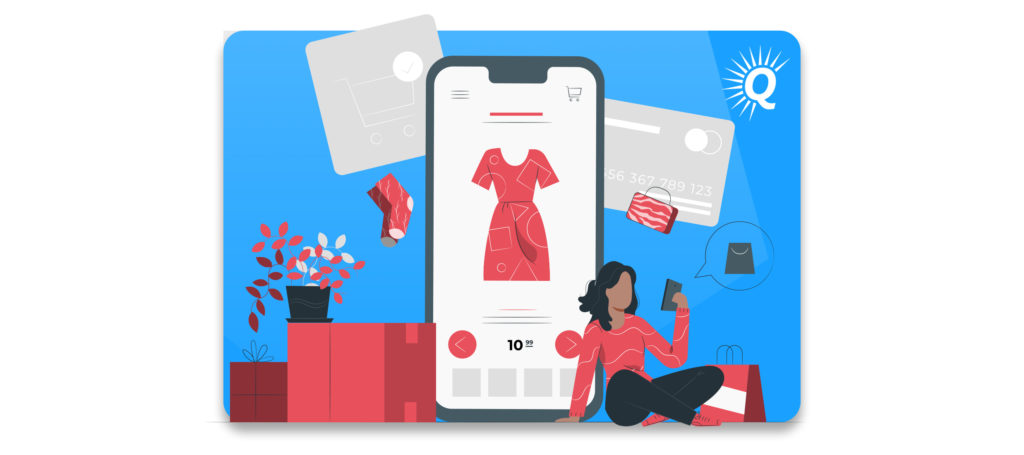

As an extension of the previous point, most inexpensive products do not include electrical components. However, there are exceptions to this rule – electrical components aren’t necessarily a deal-breaker.
Of course, there are different standards for the meaning of an “inexpensive” product. If you want a product that costs $1 to produce, then you’ll need to look for one that is pretty basic. If $5 per unit is within your budget, then you have slightly more leeway.
Use Alibaba to get product cost estimates
Common sense may give you an idea of how much a product costs to produce, but it’s always a good idea to jump on Alibaba and perform a brief search. For example, searching for “bamboo toothbrushes” will pull up a list of toothbrush suppliers, along with rough price estimates.
Selling Products With Low Competition
The best Amazon product ideas are those with high volume and little competition. Therefore, as an Amazon seller, identifying such products is one of the most important skills you will need.
Several factors indicate a profitable niche with low competition. These include:
- Few sellers
- Low listing quality
- Low quantity and quality of reviews
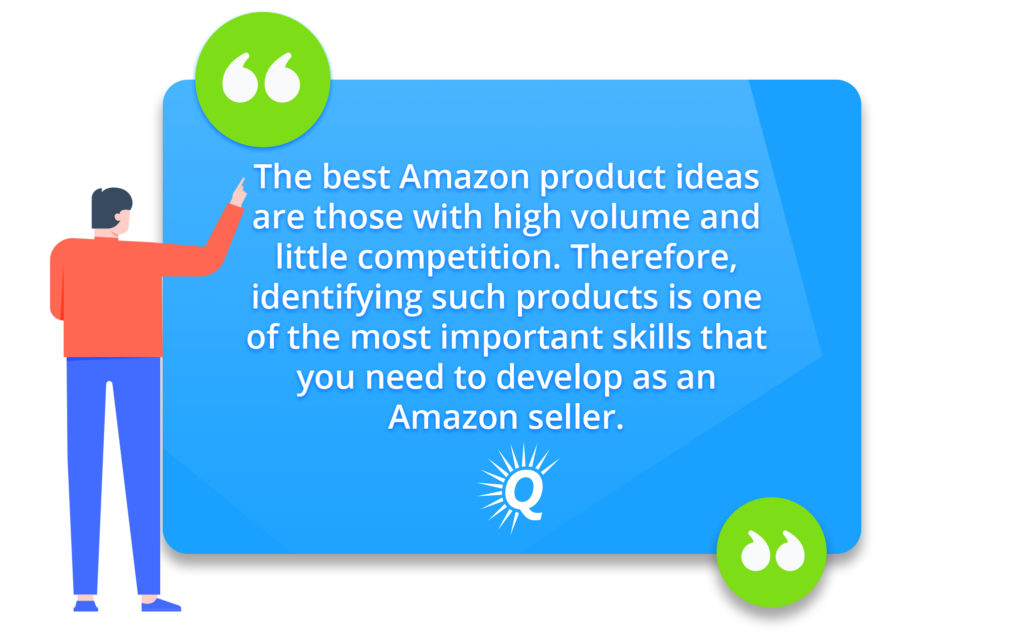

Fewer Competitors Is Better
It’s no surprise that having fewer competitors makes it easier to rank well for your product’s keywords.
If you have a product idea, try searching for it on Amazon and identify how many sellers have a similar product. If there are several pages of products to choose from, it’s a clear indication that there’s high competition and it’s going to be much more difficult than if you’re just going up against a few other sellers.
In a low competition niche, there is less keyword difficulty and it’s more likely that you’ll be able to find a low competition keyword — or several.
Look for High-Ranking Products that have Low Listing Quality
Another great way to gauge competition is to examine the highest ranking products in the search results of a product’s main keyword. If the top listings are low quality, it means that there’s room for improvement…
A few indications of low listing quality include:
- Few or low-quality product photos
- Poorly written copy
- No A+ content
- Overall lack of clarity and appeal
First of all, if a product only has two or three images, you immediately know that the listing isn’t optimized. Amazon generally allows sellers to add up to seven images per product. Not utilizing all of the available opportunities to showcase a product is an easy way to miss out on customers. As a market researcher, take fewer images as a sign of potential opportunity.
In addition, pay attention to the quality of images you come across in your market research. If they’re at all blurry, grainy, or lacking detail, there is likely room for improvement. Also, if the images aren’t showing the product’s features with sufficient detail, that’s another element of which to take note.
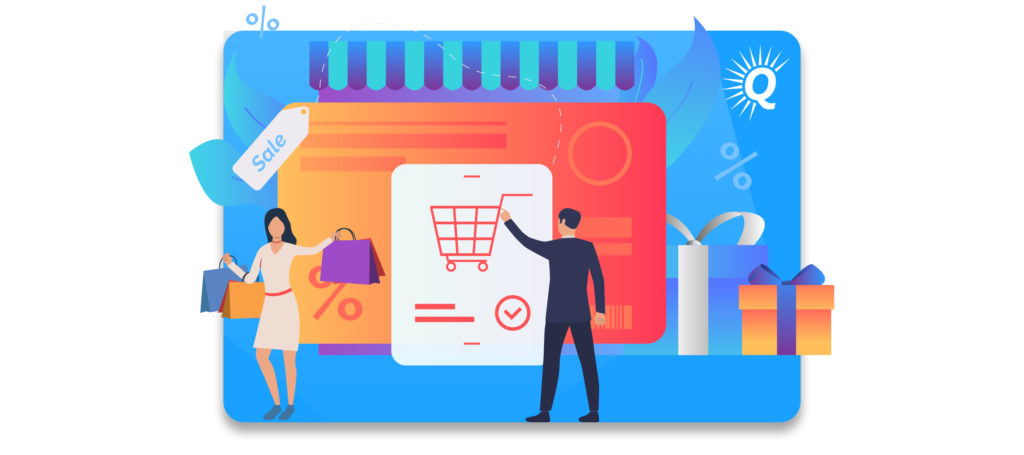

To complement the product images, a great listing should include persuasive copy that highlights all of the core features and benefits the product offers. This includes the title, bullet points, and a great product description.
If you’re reading through a product page and notice sloppy grammar errors and don’t have a clear understanding of why someone should buy the product, there’s a good chance that you’ll be able to do better.
Next, look to see if the top-ranking products are using A+ content. In short summary, A+ content allows sellers to provide visually striking images and custom text on the product.
When done well, A+ content communicates the product clearly and attractively. If the highest-ranking products aren’t using A+ content, there’s yet another area for potential improvement.
Overall, if you can find Amazon product niches in which the top sellers aren’t succeeding in all of these areas, that’s a clear sign that the competition isn’t too steep.
Look At Reviews
Reviews are perhaps the quickest indication of competition. To find low competition products, look for those that have fewer reviews and a low star rating.
Everyone knows that reviews carry a lot of weight among Amazon customers. If you perform a product search and most of the products on page one have 10,000 reviews with an average of 4.5 stars, it’s going to be very difficult to gain traction.


On the other hand, if most products on page 1 have less than 100 reviews, it’s going to be significantly easier to enter the market. Pay attention to the average review quantity and star rating of products on page 1 when doing your research.
If you can find a product with low competition and high search volume, there’s a good chance it’s a winner.
Choosing Products That Are Eligible For ‘Subscribe and Save’
Consistently attracting new customers is important. If you can keep those customers for months or years, that’s even better. Amazon’s ‘Subscribe and Save’ feature allows sellers to offer subscription purchases for many products.
What is Amazon Subscribe and Save?
Subscribe and save is a feature that allows customers to sign up for automatic, recurring orders for certain products.
For example, if a customer knows that they consume toothpaste, toilet paper, and dish soap every month, they can remove the hassle of needing to constantly place orders and instead automate the process by setting up recurring monthly orders through Subscribe and Save.
To incentivize customers to enroll in the program, Amazon offers a 5-15% discount based on the product category and quantity of products included in the program. Sellers can set up Subscribe and Save through their Seller Central account.
How Subscribe and Save Benefits Amazon Sellers
As an Amazon seller, there are many great benefits to offering products that qualify for subscribe and save. These include:
- More repeat customers
- Higher Customer Lifetime Value (CLV)
- Can spend more to acquire customers
- Sales stability
- Consistent revenue growth
- Greater ability to cross-sell
When customers purchase a product using the subscription box, there’s a good chance that they’ll continue purchasing that product from you over and over again.
When you consistently attract repeat customers, each customer becomes more valuable over time (higher CLV). For example, if you sell a $20 product and the average customer purchases 20 of them throughout their lifetime, then that customer is suddenly worth $400 (20 times the value of someone who purchases only once).


Having a high CLV means that you can spend more money acquiring a customer since you know that on average they’ll generate recurring revenue. Instead of needing to recoup your advertising for each customer on the first sale, you can instead tolerate lower margins to acquire new customers, knowing that all future sales will be more profitable.
Increased Stability, Growth Potential, and Customer Engagement
A subscription company that uses Amazon subscribe also gets to enjoy greater sales stability. Instead of relying almost entirely on keyword rankings and ad campaigns for continued sales, they have the luxury of having customers who are signed up for recurring billing. If something happens to their keyword rankings or ads, they’re not left entirely in the dark.
In all product categories, there is a ceiling you can reach when it comes to acquiring new customers each month (albeit, a very high ceiling in some categories). With Subscribe and Save, you can surpass the natural revenue ceiling that other products experience.
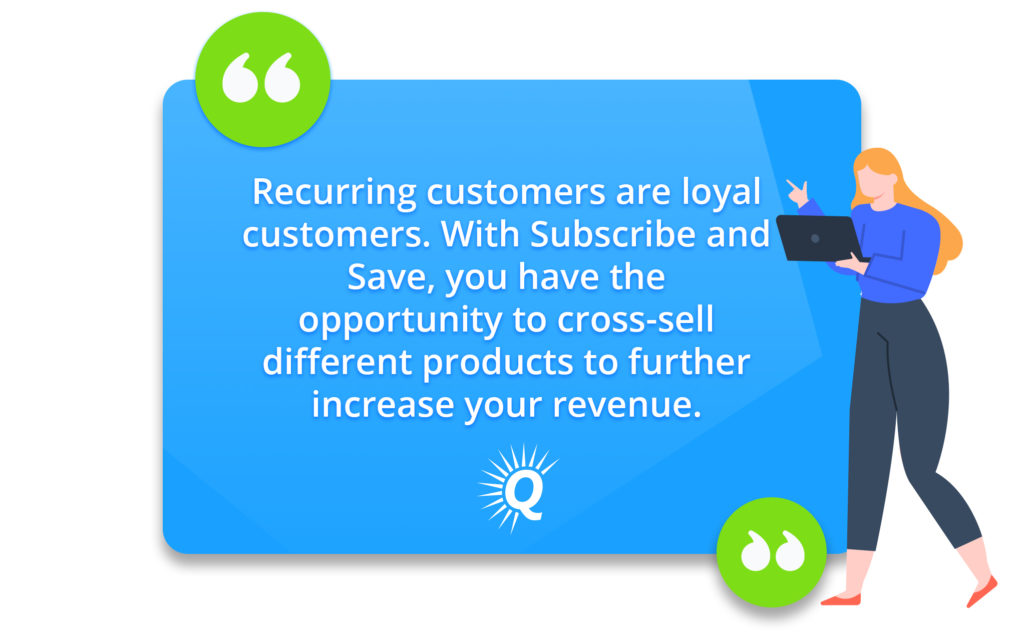

As you add more customers to Subscribe and Save, your subscription revenue continues to increase. For example, let’s say that based on your product’s rank and the monthly volume you’re able to acquire 300 new subscription customers each month. Based on this, you can expect your recurring revenue to steadily increase month after month.
Recurring customers are loyal customers. With Subscribe and Save, you have the opportunity to cross-sell different products to further increase your revenue.
Each product has several adjacent products that a segment of your target market will likely be interested in buying. If you’re selling dog food, there’s a good chance that some of your customers will want to purchase a leash. If you’re selling toothpaste, maybe some of your repeat customers will want… dental floss?
Customers who like your products enough to sign up for Subscribe and Save will almost definitely want to buy other items from you. Therefore, using a Subscribe and Save Amazon business model makes it easy to cross-sell different products in your Amazon store, all while using Amazon’s fulfillment infrastructure.
How to Research Products
Having a systematic process for finding, evaluating, and launching products is essential for succeeding on the Amazon platform.
Amazon FBA product research can be broken down into a few core components. These include:
- Identifying product opportunities
- Estimating profit margins
- Evaluating product requirements
- Finding suppliers
As an Amazon seller, the ideal product has high demand, high-profit margins, low competition, low risks, and a simple supply chain. Of course, it’s extremely rare to find a product that satisfies all of these criteria, but these elements should guide all of your product research activities.
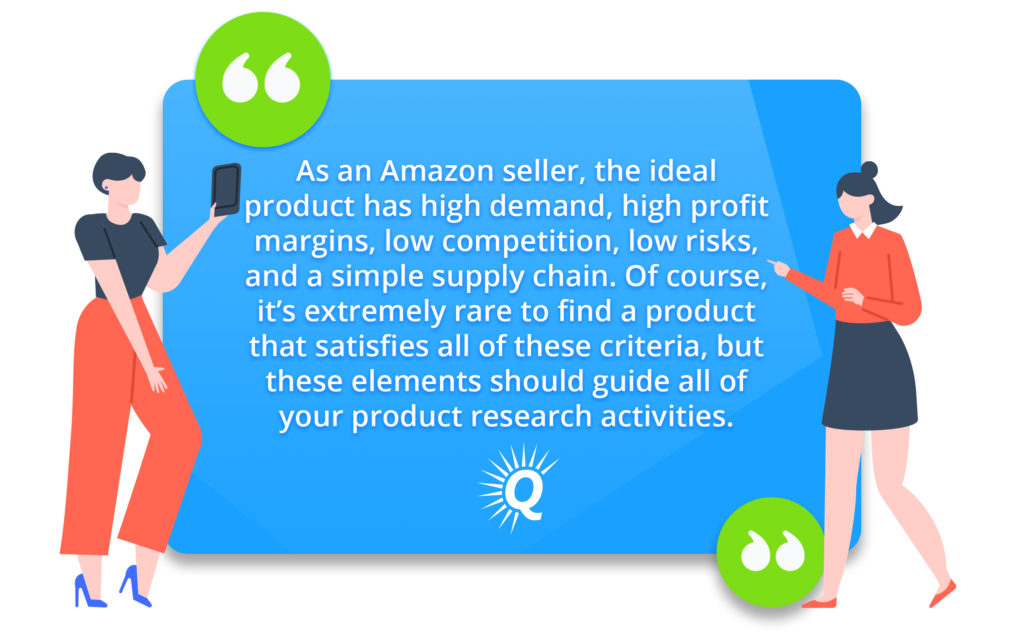

Regarding Amazon products, opportunity means that there is high demand and low competition. For most Amazon sellers, this is the first place to start.
How to Research a Product’s Sales Volume
For existing products, demand can be gauged by looking at their current sales volume, which is reflected in their Best Seller Ranking (BSR).
BSR measures the sales volume of a given product relative to all of the other products in the same category. For example, if a product is BSR #1, it means that it is currently selling more units than any other product in its category. Similarly, a product with BSR #2 is selling the second most units in its category.
When conducting product research, a product’s BSR can be found by scrolling down the Amazon product page and looking in the “Product Details” section.
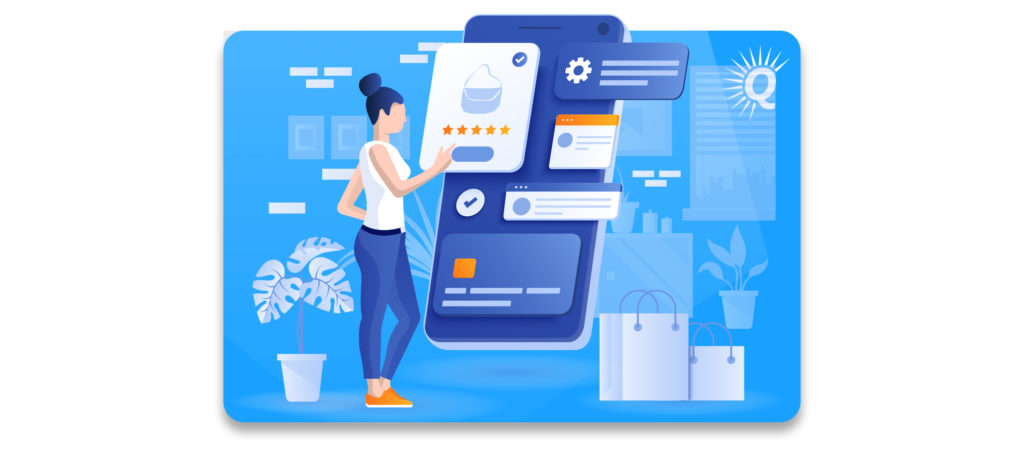

Because sales volume differs by product category, a BSR may correspond to a much different sales volume in one category than it does in another. Luckily, there is software you can use to find a great idea.
Using a simple Chrome extension, software such as Jungle Scout or Helium 10 can quickly crawl Amazon pages to generate a list of product listings, their respective BSRs, and other metrics. Because sales volume corresponds to BSR, these software tools can also give you a pretty good idea of each product’s sales volume and monthly revenue.
Look for Products with Low Competition
Earlier in this article, we discussed indicators of a low-competition product idea (few reviews, low review ratings, poor product page quality, lack of A+ content, and overall unappealing listing).
Software such as Jungle Scout and Helium 10 can help you quickly gauge the quality and quantity of your competitor’s reviews. As an Amazon seller, having product research tools such as these will be invaluable for building your business.
In addition to estimating each product’s revenue, these software tools can also display the quantity and quality of reviews on a search results page. Of course, more reviews mean more competition, while fewer reviews mean less.
How to Evaluate Product Requirements
Some products are simple and straightforward. If there are no moving parts and no special licensing requirements, then developing the product and going to market should be relatively easy.
On the other hand, if you have a product idea that involves complicated components or unique licensing requirements, or import tariffs, you’ll probably have to take a few additional steps.
Before placing an order for a new product, be sure to do your research to understand the risks or requirements that the product entails.
For many sellers, the first place to research selling requirements is directly on Amazon. For certain product categories, Amazon requires that sellers go through an application process to request approval.
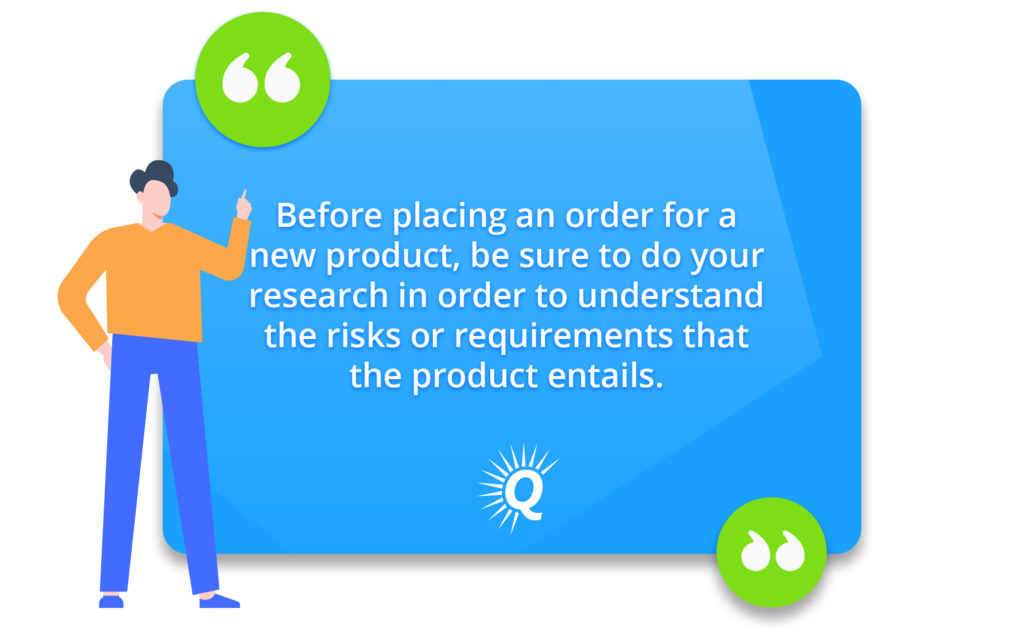

Product categories requiring Amazon’s approval include jewelry, groceries and gourmet foods, and watches, among others. Go to the categories and products requiring approval page on Amazon for a full list. Also, you can check out the restricted products page to find out what products are outright prohibited on the platform.
Products with batteries or certain other components are also subject to specific requirements and certifications on Amazon.
How to Find a Manufacturer
You’ve identified an opportunity, estimated your profit margin, and researched the product requirements. Now, it’s time to find a manufacturer and place your first inventory order.
When launching a new product, there are two routes you can take: private label and contract manufacturing.
Private Label Versus Contract Manufacturing
Private labeling is the process of finding an existing product that is already in production and then applying your own branding to it. If you’ve ever wondered why a bunch of different companies are selling the exact product in the Amazon marketplace, private labeling and retail arbitrage are the answer.
There are several advantages to private labeling, as well as one big disadvantage. These include:
- Low capital investment requirements
- No product development costs
- Quick product launch timeline
- Minimal product differentiation
When you work with a private label manufacturer, you can skip many of the hurdles associated with creating your own product from scratch. This includes avoiding product design expenses, custom mold costs, and a high Minimum Order Quantity (MOQ).
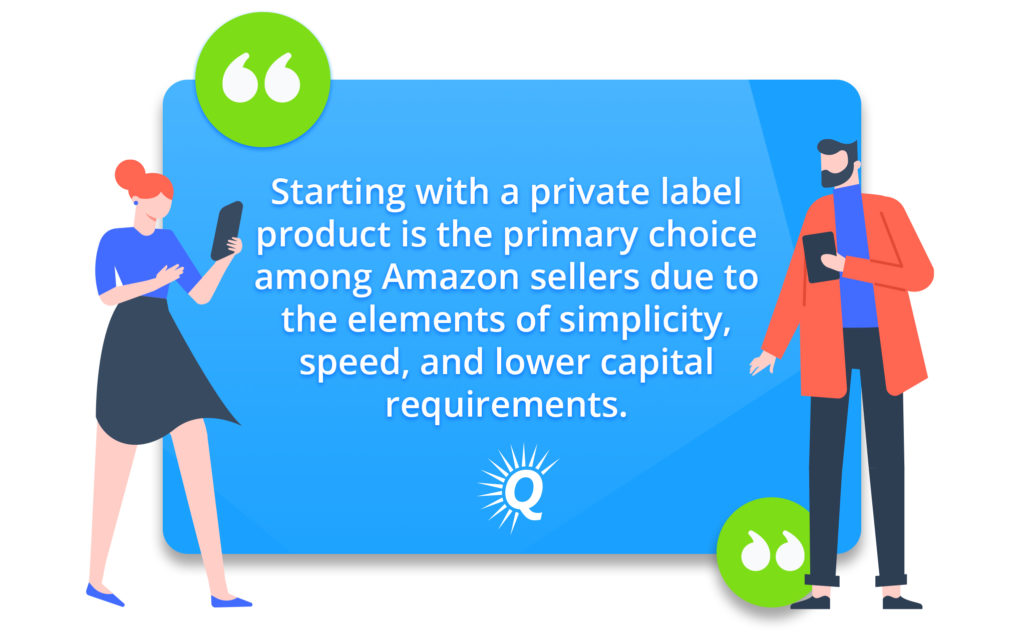

The big disadvantage is that there will probably be a bunch of other Amazon sellers offering the same exact product, so it won’t be as easy to differentiate yourself.
Contract manufacturing is completely the opposite. With contract manufacturing, there is:
- Higher capital investment requirements
- Higher product development costs
- Longer product launch timeline
- Higher potential for product differentiation.
Contract manufacturing requires that you invest in product design, custom molds, and a higher MOQ from an overseas or domestic manufacturer. Because these steps take time, the launch timeline is usually longer.
While there are drawbacks to contract manufacturing, it provides sellers with immense customization options and product differentiation potential. This allows them to avoid competition and sell a distinctly unique product.
In general, starting with a private label product is the primary choice among Amazon sellers due to the elements of simplicity, speed, and lower capital requirements.
Using Alibaba to Source Products
For most Amazon FBA businesses, Alibaba is the first place to turn to for product sourcing. With a quick search on Alibaba, you can find hundreds of suppliers for almost any product you can imagine.
Alibaba is a Chinese-based company, making it a great platform to use if you’re open to working with an overseas manufacturer. In addition to finding direct manufacturers, you’ll also notice a lot of trading companies, which act as a third party seller for other suppliers.
Although Alibaba is pretty straightforward to use, there are some important tips to keep in mind in order to find good products, negotiate great prices, and keep the process moving quickly. These include:
- Search for suppliers, not products
- Get quotes from several suppliers
- Be specific in your requests
- Set clear due dates
- Get product samples
- Establish contracts or written agreements
- Use a third-party inspection company
When using Alibaba, it’s important to search by suppliers rather than by products.
When you search by product, there’s a good chance you’ll end up requesting several quotes from the same supplier without even knowing it. Not only will this undermine your professionalism with your Chinese supplier, but it also isn’t the best use of anyone’s time.
Instead, create a single quotation request that spells out exactly what you’re looking for and then send the message to several suppliers who offer similar products.
Requesting Quotations From Manufacturers
In your quotation request, be sure to include as much detail as possible about the product you’re seeking to develop. Including relevant details such as the size, color, order quantity, and product photos will ensure that the manufacturers know what you’re looking for.
In addition to stating your product requirements, also make it clear what you want their quotations to include. For example, ask them for their product specifications, photos of their products, any necessary certificates, production lead times, and payment terms. Also, make sure to provide a quotation due date so you can establish a clear framework for the quotation process.
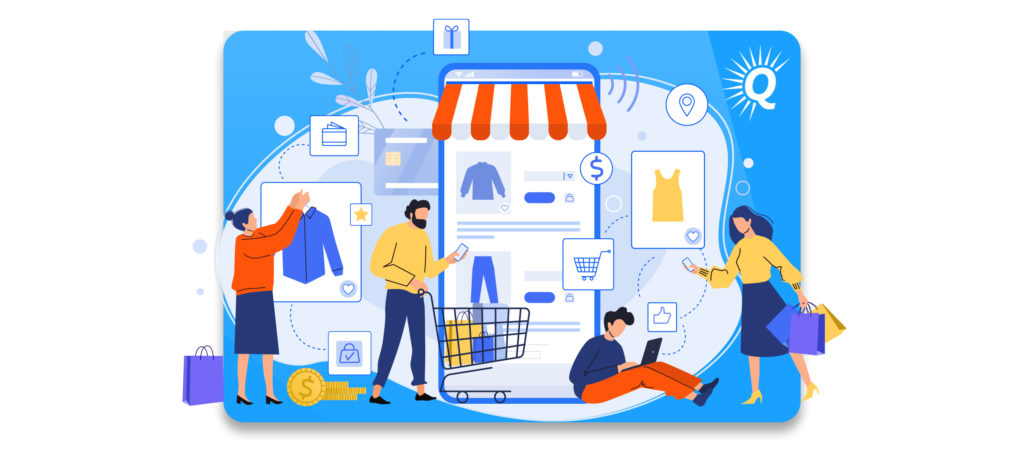

Once you have several quotations that look good, try negotiating to get the best product cost.
After narrowing it down to just a few potential manufacturers, order product samples to test product quality. If everything looks good, choose the supplier you like the best and then complete the final negotiations and contract agreements. Alibaba has some built-in agreement tools, but it’s still a good idea to consult with an attorney.
Lastly, before releasing your final payment, try to arrange a quality control inspection from a third-party inspection company.
This process can be used for finding a clothing manufacturer, technology products manufacturer, or any other kind of supplier you might be seeking.
Going to Tradeshows
Alibaba is a great place to start, but sooner or later you may want to find suppliers in person.
Live trade shows are an excellent opportunity to build relationships with suppliers, negotiate better deal terms, and discover suppliers who you may otherwise not find online.
The Asia World Expo is one of the premier trade shows for Chinese and Hong Kong-based manufacturers operating in many different industries. In the U.S., there are also numerous trade shows and events aimed at connecting U.S. suppliers with global and domestic brands.
Thinking of Selling Your Business?
Get a free, individually-tailored valuation and business-readiness assessment. Sell when you're ready. Not a minute before.
How to Import and Pay Lower Tariffs
For products with low margins, even the smallest tariff can eliminate the chances of making a reasonable profit. For products that have more wiggle room, tariffs can still greatly impact profitability and cash flow.
While it’s impossible to avoid tariffs, there are a few steps you can take to minimize your product’s import tariff and duty rates. These include:
- Researching tariffs for various countries
- Modifying supply chains
- Transshipments
- Staying up-to-date with tariffs
Different Countries Have Different Tariffs
For some products, importing from China may look much different than importing from Malaysia or India. Since tariffs are specific to countries, you need to do your research to find out what the tariff implications will be for each option.
For new products, it’s best to do your research before you start production with a manufacturer. In addition to comparing the production costs between various manufacturers, you should also look at the import tariffs that will be incurred through each option as that will affect your total Cost of Goods Sold (CoGS).
For some existing supply chains, businesses can avoid import tax or customs duty by moving production to a different country. Of course, such a move may be no small undertaking, but it could be worthwhile depending on the total financial savings.
What are Transshipments?
The term “transshipments” is applied when the manufacturing country’s tariff is higher than other countries.
A transshipment is shipping inventory from the country of origin to another country before having it shipped to the destination country. By doing so, you can avoid paying the high tariffs associated with importing from the origin country.
For example, if a business is purchasing Chinese goods that have a high tariff or import duty, they may choose to have inventory shipped to a different country such as Malaysia where the tariffs are significantly lower. From there, the inventory is imported to the United States without the business needing to pay the higher Chinese tariffs.
In some cases, analyzing tariffs can dramatically lower your total cost of an imported good.
Stay Current with Tariff Changes
In the modern climate of business and politics, tariffs can change quickly and dramatically. Trump’s tariffs changed business for companies that sell solar panels, steel, aluminum, and other products, and it’s not uncommon for a country to enact a retaliatory tariff in response to another government’s policies.
Staying up-to-date with current tariffs allow you to be aware if the tariffs change in your favor.
Conclusion
Whether you want to grow for years or eventually sell, building a successful Amazon FBA business all starts with identifying opportunities, doing your research, and building an effective supply chain. Although it requires some time and focus, developing the right products can set the foundation for years of growth and excitement as an Amazon entrepreneur.





